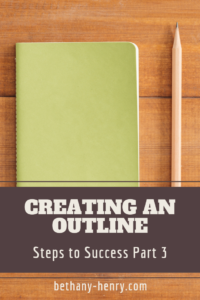Steps to Success is a series walking us through the process of writing a novel from beginning to end. As always, personal preferences and experiences differ. This guide is based in part on my own experiences as well as from authors I have worked with and/or learned from along the way.

Today we’re talking about outlining and I can already hear the protests: “Do I really need to outline?” “Outlining is something I did in 5th grade assignments- aren’t I past that by now?” “It feels like homework/busywork.” “I know plenty of writers who don’t outline.”
I hear you.
And… you’re correct! There are successful writers who don’t outline.
We don’t need an outline in order to write. But most of us need an outline if we want to write quickly and well.
For us busy writers, quickly and well is our favorite combo 🙂
Basically an outline is a plan for your writing. An outline can take many forms and I’m not here to be legalistic about it or insist your outline needs numbered bullets or a certain wordcount. It could be three sentences written on an old napkin or it could be a color coded excel spreadsheet. It can take whatever form you like!
The often quoted Benjamin Franklin is credited with saying, “If we fail to plan, we plan to fail.” In almost every area of life, plans are important if we want to achieve our goals.
Having a plan/outline enables us to both write faster in our first drafts (since we already know where we are going) and faster in our revisions (since our work is coherent enough to be revised instead of needing to be completely scrapped or reworked).
Today we’ll explore 4 different types of outlines as well as a few key items we want to think about to ensure we’re setting our drafts up to be the best they can be.
Before we start you may want to take a look at Steps to Success Part 1: Getting Started and Steps to Success Part 2: Developing Content if you haven’t already. These will set you up with the starting point and basic content you need for your outline.
Ready? Let’s go.

The Very Basic Outline
At its core, every story should have 4 basic points:
- A character with a problem
- The character trying to solve the problem and failing
- Things getting worse
- Character using what they’ve learned/accomplished in order to overcome problem
Does that sound about right to you? Obviously there’s a lot of wiggle room here for each story to be its own thing but these core items give a story its solid shape and framework.
If you’re skimming through here and not so into outlining (Hi pantsers! I’m glad you’re here!) I’d suggest you at least take note of this basic outline and see how it fits in with your writing. After all, it’s only 4 points so it can’t be that scary 😉
Besides these basic story points, a few other items to be keeping in mind as we outline are:
- The plot/main events of our story
- Our character arcs/development
- Setting of story
- Story themes
Setting up the Story: 4 Ways to Outline
This is by no means an exhaustive list but it covers 4 popular ways to set up an outline for your story. I frequently mix and match elements of different strategies at different times depending on what I’m working on. Find what works for you and use it!
-
The Scene List
This is pretty much what it sounds like. Events and scenes are listed out in chronological form providing a straightforward timeline of the story for the writer to then follow. I’ve done this at times with various colors of sticky notes along with pictures… it doesn’t *need* to be boring!
Pros: Straightforward, simple, and somewhat reminiscent of grade school.
-
The Three Act Structure
The three act structure is a popular storytelling technique that can be adapted to help structure most novels. It breaks the story into (you guessed it) three acts which not only makes the writing less overwhelming than dealing with a whole draft at once, but it also gives us a good idea of what should be happening at which point in the story.
Act 1- Set up of story, establish character and setting, introduce problem and why it matters
Act 2- Character is trying different things to solve the problem, things are getting worse
Act 3- Final confrontation/climax, problem solved, resolution of story
There’s a lot more info on this concept elsewhere, this is the general idea. To use this as an outline structure we can enter our story elements into the different acts.
Pro: Breaks story into smaller pieces to handle and provides framework for pacing of action.
-
Working Backwards
Yup, in this one we actually start at the end of the story and work ourselves back to the beginning. This is especially helpful for mysteries or if you have a complicated climax. Essentially the outline can look like either of the outlines above, you just start at the end to ensure all the bits and pieces you are envisioning will be accounted for.
Pro: Helpful for complicated endings or if you’re one of the people who likes to know the ending first.
-
Hero’s Journey
The hero’s journey is a story structure that was recognized and written about by Joseph Campbell in his book The Hero with a Thousand Faces. Campbell illustrated that a common character arc can be followed through many stories:
- Character starts in the ordinary world
- Character receives a call to adventure- there is a problem or challenge to overcome (They may attempt to refuse the call to adventure)
- Character has help or a mentor
- Character leaves ordinary world and encounters tests, allies, and enemies
- Character encounters setbacks and must try new ideas
- Character faces huge struggle
- Character overcomes struggle and is “reborn”
- Character returns home and must use what they have learned
This structure focuses on the main character’s personal arc which can be useful especially for stories with only one protagonist. By fitting our story concepts into the hero’s journey we can have a good picture of how our plot and our character development work together.
Pro: Good development of character arc.

After all that, how’s your story looking so far? An outline doesn’t need to be perfect but it will be a place to start from and to work with! Once we have a basic outline for our story written we can look at it to see what might need some work.
That’s what’s so great about outlines- we can keep adding to them and making changes as we flesh out our story concept.
Remember the Villain
Something to pay attention to when planning a novel is what the bad guy is up to. Ever read a book where the villain was kinda lame? I’m totally guilty of focusing on my hero and neglecting my villain. Yet the best stories I read are the ones in which the bad guy is good… and by good I mean really really bad 🙂 Just taking some time now to brainstorm your bad guys motivations will go a long way in helping them develop into a complex character.
Plot Hole Finder
This is one of the biggest reasons why outlining is so important, it is an excellent way of finding where our story is missing important pieces. How else would you know that you have a big plot problem? I’d much rather find out my problems before writing a 80k word draft so that I can brainstorm what to do about it instead of needing to rewrite everything.
We want to look at things like: plot logistics/coherence, character arcs and motivation, theme, setting, tension levels, consistent POV, and of course our villain.
We’ll probably find areas that need some work (I know I always do!) so we can either add to our outline or just jot down things we’ll know we need to keep in mind address later.
Either way we’re on our way to a story that will ultimately be stronger and better than before and that, my friends, is a win!
Do you have an outlining technique that works for you or are you experimenting with how to set up your story? Share below- I’d love to hear what works or doesn’t work for you!




